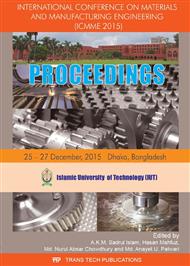[1]
M. Wu, Y. Wu, C. Chao, C. Lin, C. Wu, Crystalline ZrTiO4-Gated Ge Metal-Oxide-Semiconductor devices with amorphous Yb2O3 as a passivation Layer, IEEE Trans. on Nanotech. 12 (2013) 1018-1021.
DOI: 10.1109/tnano.2013.2283252
Google Scholar
[2]
N. P. Maity, R. Maity, R. K. Thapa, S. Baishya, Study of Interface Charge Densities for ZrO2 and HfO2 based Metal-Oxide-Semiconductor Devices, Advances in Material Science and Engineering 2014 (2014) Article ID 497274 1-6.
DOI: 10.1155/2014/497274
Google Scholar
[3]
N. P. Maity, R. R. Thakur, R. Maity, R. K. Thapa, S. Baishya, Analysis of Interface Charge Using Capacitance-Voltage Method for Ultra Thin HfO2 Gate Dielectric based MOS Devices, Procedia Computer Science, 5 (2015) 757-760.
DOI: 10.1016/j.procs.2015.07.470
Google Scholar
[4]
N. P. Maity, R. Maity, R. K. Thapa, S. Baishya, Effect of Image Force on Tunneling Current for Ultra Thin Oxide Layer Based Metal Oxide Semiconductor Devices, Nanoscience and Nanotechnology Letters 7 (2015) 331-333.
DOI: 10.1166/nnl.2015.1970
Google Scholar
[5]
D. Hoogeland, K. B. Jinesh, F. Roozeboom, W. Besling, M. Van, W. Kessels, Plasma-assisted atomic layer deposition of TiN/Al2O3 stacks for metal-oxide-semiconductor capacitor applications, Journal of Applied Physics 106 (2009) 114107 1-7.
DOI: 10.1063/1.3267299
Google Scholar
[6]
N. P. Maity, R. Maity, R. K. Thapa, S. Baishya, Image Force Effect on Tunneling Current for Ultra Thin High-K Dielectric Material Al2O3 Based MOS Devices, J. Nanoelectronics and Optoelectronics 10 (2015) 645-648.
DOI: 10.1166/jno.2015.1812
Google Scholar
[7]
D. Souza, J. Kiewra, Y. Sun, A. Callegari, D. Sadana, G. Shahidi, D. Webb, Inversion mode n-channel GaAs field effect transistor with high-k/metal gate, Applied Physics Letters 92 (2008) 153508 1-2.
DOI: 10.1063/1.2912027
Google Scholar
[8]
N. P. Maity, R. R. Thakur, R. Maity, R. K. Thapa, S. Baishya, Interface Charge Density Measurement for Ultra Thin ZrO2 Material based MOS Devices Using Conductance Method, Procedia Computer Science, 5 (2015) 761-765.
DOI: 10.1016/j.procs.2015.07.472
Google Scholar
[9]
G. Adamopoulos, S. Thomas, D. Bradley, M. McLachlan, T. Anthopoulos, Low-voltage ZnO thin-film transistors based on Y2O3 and Al2O3 high-k dielectrics deposited by spray pyrolysis in air, Appl. Physics Lett. 98 (2011) 123503.
DOI: 10.1063/1.3568893
Google Scholar
[10]
N. P. Maity, A. Pandey, S. Chakraborty, M. Roy, High-k HfO2 based Metal-Oxide-Semiconductor Devices Using Silicon and Silicon Carbide Semiconductor, J. Nano - Electron. Phys. 3 (2011) 947-955.
Google Scholar
[11]
N. P. Maity, S. Chakraborty, M. Roy, Silicon and Silicon Carbide Based Metal-Oxide-Semiconductor Devices Using HfO2 and SiO2 Gate Dielectric, International Journal of Applied Engineering Research 6 (2011) 391-399.
Google Scholar
[12]
N. P. Maity, R. K. Thapa, S. Baishya, Comparison of Different High-k Dielectric Materials in MOS Device from C-V Characteristics, Advanced materials Research 816 (2013) 60-64.
DOI: 10.4028/www.scientific.net/amr.816-817.60
Google Scholar
[13]
E. Nicollian, J. Brews, MOS (Metal Oxide Semiconductor) Physics and Technology, Wiley-Blackwell Publishers, USA, (2002).
Google Scholar
[14]
B. E. Deal, Standardized terrninulogy for oxide charge associated with thermally oxidized silicon, IEEE Transactions on Electron Devices 27 (1980) 606-608.
DOI: 10.1109/t-ed.1980.19908
Google Scholar
[15]
C. Lu, K. Liao, C-Y Lu, S-C Chang, T-K Wang, F-C Hou, Y-T Hsu, Tunneling component suppression in charge pumping measurement and reliability study for high-k gated MOSFETs, Microelectronics Reliability 51 (2011) 2110–2114.
DOI: 10.1016/j.microrel.2011.04.021
Google Scholar
[16]
R. Engel-Herbert, Y. Hwang, S. Stemmer, Comparison of methods to quantity Interface Trap Densities at dielectric/III-V Semiconductor Interfaces, J. of Appl. Physics 108 (2010) 1241011.
DOI: 10.1063/1.3520431
Google Scholar


